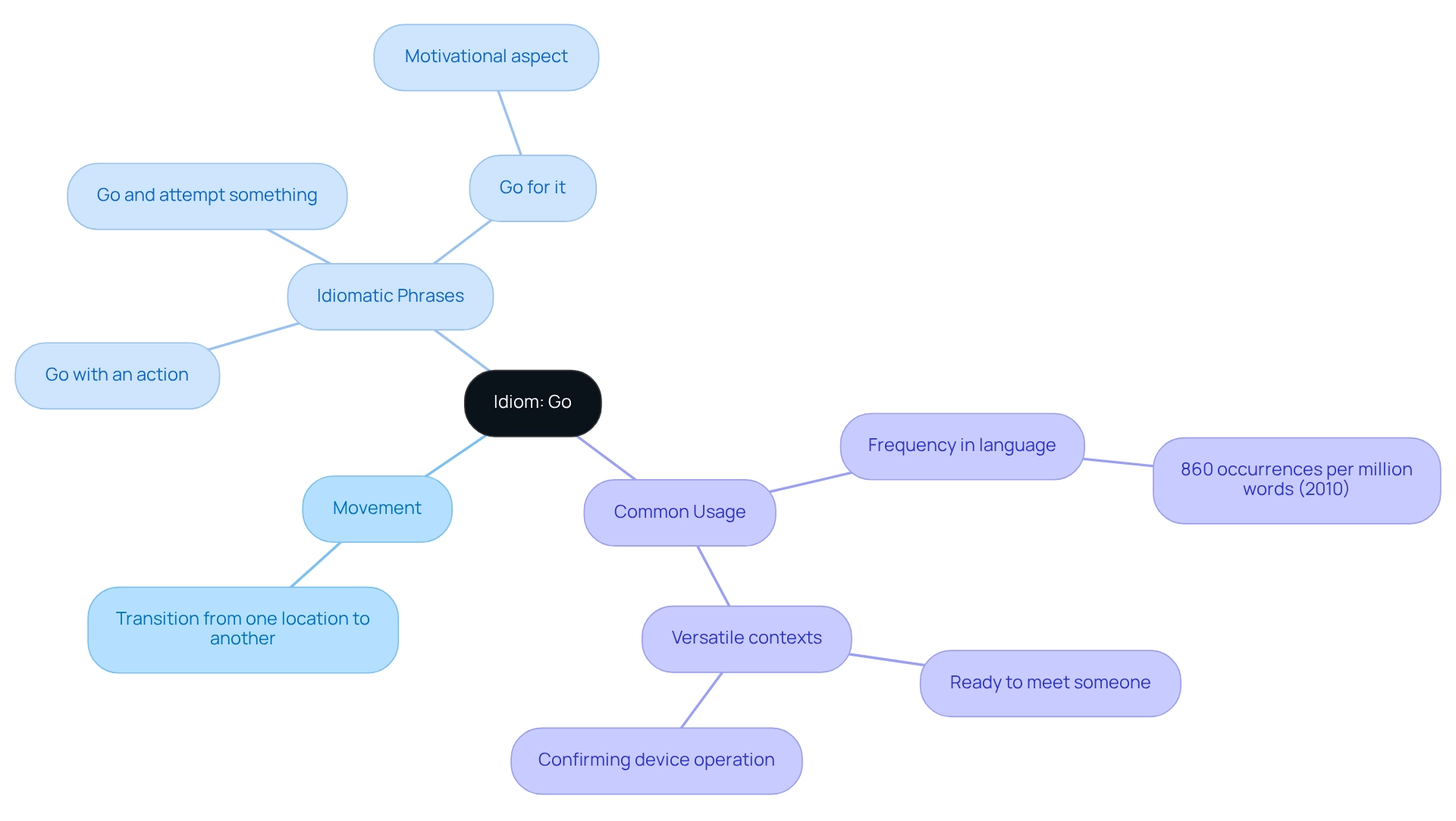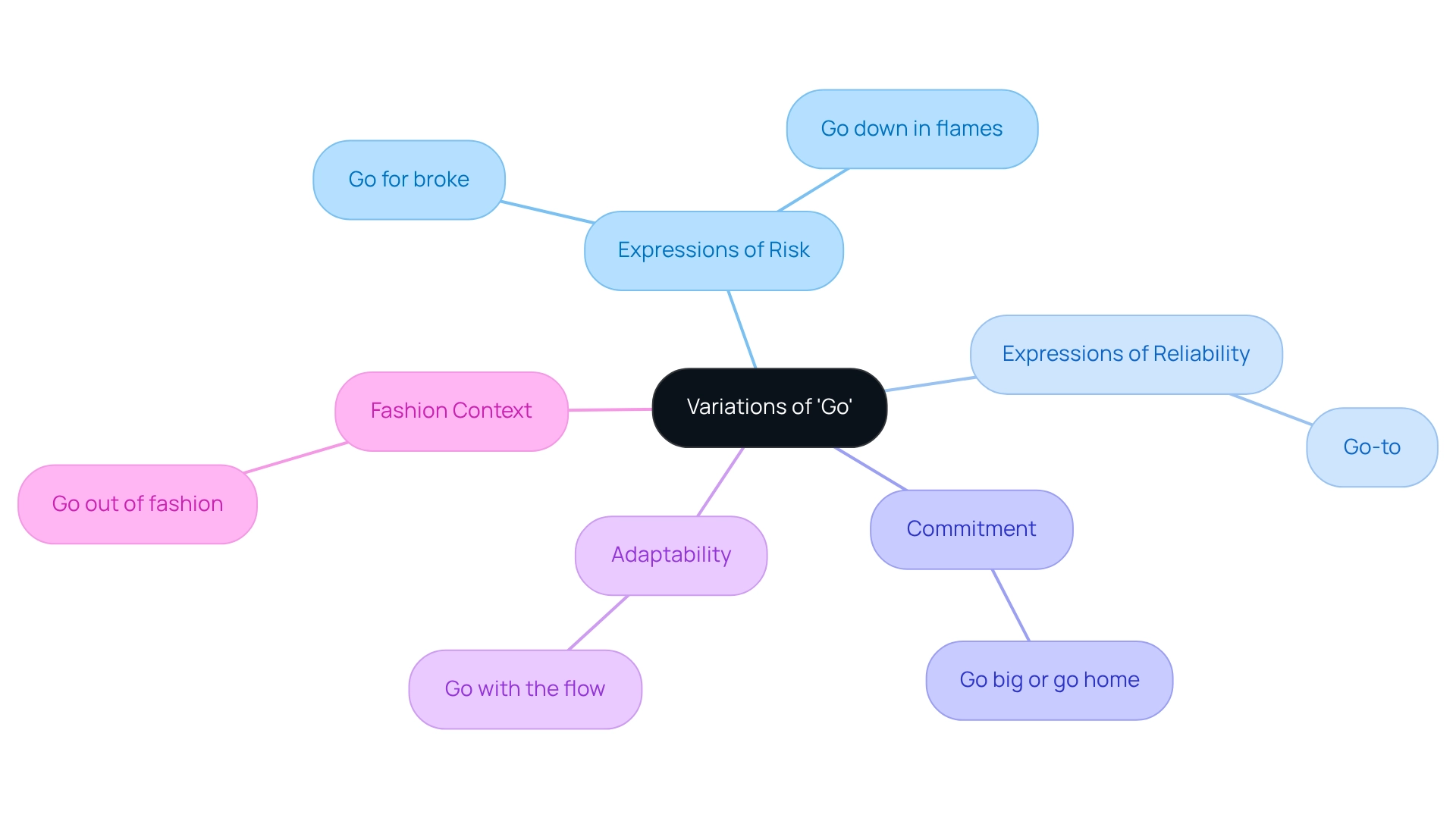Overview
The idiom 'go' embodies a multitude of meanings associated with movement and action, establishing itself as a fundamental element in various idiomatic expressions such as 'go for it' and 'go with the flow.' This article emphasizes its versatility in both formal and informal contexts. Furthermore, it illustrates how the historical roots and evolving usage of 'go' reflect the adaptability of the English language in conveying complex ideas succinctly. By understanding this idiom, one can appreciate the richness of English expressions and their ability to encapsulate intricate concepts.
Introduction
The idiom "go" presents a compelling opportunity to explore the richness and versatility of the English language. How often do we consider the depth of a term that originates from the simple act of movement? This seemingly straightforward word has evolved into a treasure trove of expressions, conveying a multitude of actions and sentiments.
For instance, when we encourage someone to "go for it," or indicate approval with "the project is a go," we capture the essence of human experience in diverse contexts. Furthermore, as "go" weaves its way through both casual conversations and formal discourse, its adaptability underscores its integral role in effective communication.
This article delves into the multifaceted nature of the idiom "go," examining its origins, usage, and the nuances it brings to language. Ultimately, we showcase how a single word can encapsulate complex ideas and emotions, inviting readers to reflect on their own understanding of language.
Define the Idiom 'Go'
The expression 'go' embodies a spectrum of meanings, primarily centered on the idea of movement or transition. At its core, 'to go' signifies the act of moving from one location to another. However, in the realm of idiomatic phrases, it extends to convey various actions or states, such as:
- 'to idiom go with an action'
- 'to idiom go and attempt something'
For example, the expression 'go for it' acts as a motivation to take a chance or make an effort, demonstrating its inspirational aspect. This adaptability makes the idiom go a vital element in idiomatic expressions, allowing it to fit seamlessly into diverse contexts and conversations.
Furthermore, statistics show that the expression 'go' appears often in the language, with occurrences reaching 860 per million words in 2010. This underscores its integral role in everyday language. Overall, the expression 'go' exemplifies the richness of the language, showcasing its ability to convey complex ideas through simple terms.

Context and Usage of 'Go'
The idiom go is prevalent in both formal and informal contexts, showcasing its versatility in English communication. Have you ever considered how often we use 'go' in our daily conversations? In casual settings, phrases like 'Let's go out for dinner' reflect everyday plans, while in formal contexts, one might hear 'the project is a go,' which can also be seen as an idiom go, indicating official approval to proceed. This adaptability encompasses various idiomatic phrases, including how the idiom go 'the extra mile' signifies putting in extra effort beyond expectations.
Furthermore, statistics reveal that expressions like 'go' are integral to effective communication, enhancing clarity and engagement in both personal and professional interactions. For instance, in business communication, idiom go phrases can convey a sense of decisiveness and commitment, making them essential for delivering messages succinctly. The ability to navigate between formal and informal uses of the idiom go not only enriches language proficiency but also fosters better understanding in diverse contexts.
In addition, a case study on the methodology for searching expressions in COCA highlights how such phrases have been analyzed over time, providing insights into their usage across genres. Moreover, as noted by Boers, learning figurative phrases like sayings through common themes can greatly enhance retention, facilitating a deeper understanding for learners. Although the theme of fools and foolishness appears infrequently in phrases, it demonstrates the wider context of idiomatic phrases in the language.
Organizations such as Oxford International are actively assisting learners in enhancing their language skills and using idiomatic phrases confidently. This emphasizes the significance of idioms in effective communication. Are you ready to explore how mastering the idiom go can improve your language skills?
Origin of the Idiom 'Go'
The term 'go' traces its roots back to Old English, originating from 'gan,' which signified 'to advance' or 'to depart.' This foundational meaning has evolved significantly over the centuries, leading to a rich tapestry of idiomatic expressions that feature the idiom go. For instance, the expression 'make the grade' illustrates how the term has been contextualized in various domains, particularly in relation to performance standards, as seen in the powerful Allegheny steam locomotives that successfully navigated steep gradients. This case study emphasizes the phrase's origins and contrasts its historical context with modern interpretations.
Research indicates that the evolution of 'go' reflects broader linguistic trends, showcasing how a simple verb can acquire diverse meanings and applications. Statistical analyses reveal that expressions containing the idiom go are prevalent in both British and American literature, underscoring their adaptability and relevance across different contexts. Significantly, Bartlett’s test of sphericity was notable with a chi-square of 1,244.31 and p < .001, indicating a strong correlation in the usage of these expressions.
Furthermore, expert opinions emphasize the dynamic nature of language, illustrating how cultural shifts influence the development of phrases. Katherine White, an Associate Curator, expressed, 'I was terrified. My mind was like a big empty house that you knew you used to live in,' reflecting the emotional journey of language evolution. Overall, the historical development of the idiom 'go' illustrates the adaptability of the English language and its ability to change in response to societal shifts, which is especially significant in the realm of concurrent programming and expressions in the Go language.
Key Characteristics and Examples of 'Go'
The idiom 'go' stands out for its remarkable versatility in conveying action, intention, and approval across diverse contexts. For example, the idiom 'go ahead' signifies permission to proceed, reflecting a sense of approval, as the idiom 'go' suggests. In a similar vein, the idiom 'go with the flow' encourages adaptability, inviting individuals to embrace change and navigate through the uncertainties of life. Another illustrative instance of the idiom 'go' is 'go off on a tangent,' which describes the act of deviating from the main topic during a discussion and showcases its capacity to articulate shifts in focus. These expressions not only highlight the phrase's flexibility but also underscore its integral role in enriching English communication, making it a powerful tool for conveying nuanced meanings.
Based on a meta-analysis of expression studies, the processing of phrases like 'go' is influenced by factors such as familiarity and decomposability, which are crucial for effective communication. Furthermore, logistic mixed effects regression analyses have shown that subjective characteristics of expressions significantly contribute to the objective understanding of these phrases, emphasizing the importance of comprehending them in language. As Roeland van Hout pointed out, the statistical insights into expressions can provide a deeper understanding of their significance in communication. In the realm of concurrent programming, phrases in the Go language exhibit similar traits, where terms like 'go routine' embody the action-oriented essence of the language, further enriching the discourse surrounding the term 'go.
Variations and Related Terms of 'Go'
Variations of the idiom go include phrases like 'go for broke,' which signifies risking everything for a chance at success, and 'go down in flames,' denoting a spectacular failure. Other notable expressions include 'go-to,' referring to something or someone that is reliable or preferred in specific situations. These variations emphasize the expression's versatility and its essential role in articulating complex ideas succinctly in English.
For instance, in popular culture, phrases like 'go big or go home' highlight the importance of commitment and ambition, while 'go with the flow' encourages adaptability in changing circumstances. This latter phrase is illustrated in the case study titled 'Go With the Flow,' where an individual chooses to accompany friends heading to the beach rather than insisting on visiting the movies, showcasing the expression's practical application.
Furthermore, the quote 'Ruffles on the hem quickly went out of fashion' exemplifies how 'go' can be used in a fashion context, further enriching the discussion. The statistic that '60-80 people go missing each weekend' highlights the versatility of the word 'go' in various scenarios. Such idiomatic expressions enrich the language, allowing speakers to convey nuanced meanings efficiently. Overall, the idiom go has been widely adopted in modern English, reflecting its relevance and adaptability in everyday communication.

Conclusion
The exploration of the idiom "go" reveals its profound impact on the English language, showcasing its versatility and rich contextual meanings. Originating in Old English as a simple term for movement, "go" has evolved into a cornerstone of effective communication, widely used in various idiomatic expressions. Its ability to convey actions, intentions, and sentiments enriches both casual conversations and formal discourse, making it a vital tool for expressing complex ideas succinctly.
As demonstrated throughout the article, "go" is not merely a word; it embodies motivation, adaptability, and decisiveness. Phrases like "go for it" and "go with the flow" illustrate how this single term encapsulates encouragement and acceptance of change, respectively. Furthermore, the statistical prevalence of "go" in everyday language underscores its integral role in fostering clarity and engagement across various contexts.
Ultimately, recognizing the multifaceted nature of "go" invites a deeper appreciation for the dynamic evolution of language. As idioms like "go" continue to adapt and thrive in modern communication, they remind us of the richness of English and the power of language to encapsulate the nuances of human experience. Embracing such expressions not only enhances language proficiency but also facilitates a more profound understanding of the world around us.
Frequently Asked Questions
What does the expression 'go' primarily signify?
The expression 'go' primarily signifies the act of moving from one location to another, but it also encompasses a range of meanings in idiomatic phrases related to actions or states.
Can you provide examples of idiomatic phrases that use 'go'?
Yes, examples include 'go with an action' and 'go and attempt something.' A specific phrase, 'go for it,' serves as motivation to take a chance or make an effort.
How prevalent is the expression 'go' in the English language?
Statistics indicate that the expression 'go' appears frequently in language, with occurrences reaching 860 per million words in 2010, highlighting its integral role in everyday communication.
In what contexts is the idiom 'go' used?
The idiom 'go' is used in both formal and informal contexts. For instance, in casual settings, one might say, 'Let's go out for dinner,' while in formal contexts, one might hear, 'the project is a go,' indicating official approval to proceed.
What does the idiom 'go the extra mile' mean?
The idiom 'go the extra mile' signifies putting in extra effort beyond what is expected.
Why are idiomatic phrases like 'go' important in communication?
Idiomatic phrases like 'go' enhance clarity and engagement in communication, conveying decisiveness and commitment, which are essential for delivering messages succinctly in both personal and professional interactions.
How can learning idiomatic phrases improve language skills?
Learning idiomatic phrases through common themes can enhance retention and facilitate a deeper understanding of the language, as noted by researchers like Boers.
What organizations assist learners in mastering idiomatic phrases?
Organizations such as Oxford International are actively helping learners enhance their language skills and use idiomatic phrases confidently.




